It’s interesting that Chevy – GM – offers two iterations of the Equinox. One of them sells really well.
The other not so much.
You can probably guess which one – and why.
The Equinox is a compact-sized crossover that seats five in two rows. It’s also Chevy’s best-selling model after the Silverado 1500 pickup. So it’s very important – to Chevy – to not mess that up. And that’s probably why there hasn’t been any move to “electrify” it, even partially (i.e., make it into a hybrid). Because that’s not what most Equinox buyers are interested in.
For the few who might be, Chevy also sells a battery-powered device called Equinox – but it’s sold as a separate model.
The regular Equinox has a starting price of $28,600 for the base LT trim with front-wheel-drive; the optional all-wheel-drive system bumps the MSRP up to $30,600. The two other available trims – RS and Activ – have the same sticker price of $33,000 but differ in their cosmetics, with the RS being the sportiest-looking of the two and the Activ the most rugged-looking.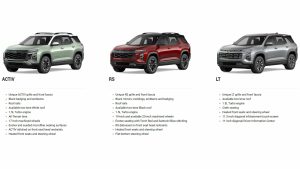
Regardless of trim, all Equinoxes come standard with the same 1.5 liter four cylinder engine and either a CVT automatic transmission (FWD versions) or an eight speed automatic (AWD versions).
It competes with other compact-sized crossovers in the same price range such as the Toyota RAV4, Honda CR-V, VW Tiguan and Hyundai Sante Fe Sport, among others – but its most interesting rival may be its battery-powered stablemate, which is both similar and very different.
What’s New for 2025
The Equinox gets a major cosmetic makeover (inside and out) for the new model year but remains mostly the same under skin.
What’s Good
Looks more like an SUV now than a crossover – for those who like the more hunky appearance of an SUV.
Standard dual LCD displays – for those who like the smartphone look.
Conventional eight speed automatic is standard with AWD-equipped versions.
What’s Not So Good
Standard (and only available) engine is small and so relies on turbo boost to generate adequate power to move this 3,428 lb. small crossover.
A continuously variable (CVT) automatic is standard with front-drive versions.
Though slightly larger than rivals like the RAV4, it has less cargo room.
As already mentioned, every Equinox comes with the same 1.5 liter four cylinder engine. It has a turbocharger – because it needs boost to produce enough power (175 hp) to adequately move this pretty heavy Chevy. With a driver and passenger of average weight on board, this compact crossover approaches two tons.
In the Before Time, a vehicle this heavy would have at least a V6 under the hood. Fours this small were for small cars that weighed half or less what this crossover weighs. For instance, a 1984 Chevy Chevette – which was just over 2,000 lbs – was powered by a perfectly appropriate 1.6 liter engine. But an engine that size doesn’t make enough power for twice that weight. Which is why this heavy Chevy’s 1.5 liter engine is turbocharged.
The upside is adequate power – and adequate performance. The Equinox can get to 60 MPH in just over 8 seconds; an ’84 Chevette needed about twice as long to reach the same speed.
The downside is that power requires pressure – in the form of near-constant boosting (via the turbocharger) to make it. That, in turn, is harder on this smaller engine and may reduce its life vs. a larger engine that doesn’t need a turbo to make as much or even more power. Like the 2.5 liter four (no turbo) that’s standard in the Toyota RAV4. It makes 203 horsepower without turbocharging.
The larger-engined RAV4 also gets better gas mileage: 27 city, 35 highway vs. 26 city, 31 highway. Normally, you’d expect to get better mileage out of a smaller, less powerful engine.
On the upside, you do get much more range out of this engine than you would from the battery in the electric iteration of the Equinox. As well as more honesty about the range. The gas-engined Equinox can go 387 miles in stop-and-go city driving on 15 gallons of gas and 461 miles on the highway. The electric iteration of the Equinox touts 319 miles of range on a fully charged battery. Like all battery powered vehicles, this is not separated out into city and highway – which is an interesting omission because there is typically a big difference in range, city vs. highway driving when it comes to battery powered devices.
EVs go farthest on a charge when they are not moving very fast (or at all). This is because they do not burn much energy when they’re not moving fast (or at all). But it takes a lot more energy to keep them moving at highway speeds. The electric iteration of the Equinox may indeed go 319 miles in city driving. But it won’t go nearly that far on the highway – and that greatly limits how far you can go on the highway because of the time it takes it get going, again.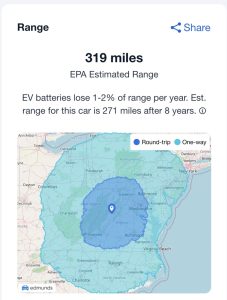
The gas-engined Equinox’s 461 miles of highway range is probably twice the highway range of the electric iteration of the Equinox.
If you buy the front-drive version of the gas-engined Equinox, you get a CVT automatic while AWD-equipped models get a new eight speed conventional automatic that shifts through gears as opposed to varying through ranges. As a rule the latter are less long-term reliable than the former – and some people do not like the shiftless feel of CVTs, which tend to keep the engine’s revs up during acceleration.
So why a CVT? Because – usually – there’s a small uptick in gas mileage, because CVTs are more efficient. And that’s the case here. The front-drive Equinox with the CVT rates the already mentioned 26 city, 31 highway. With AWD – and the conventional eight speed automatic you get with that – mileage is 24 city, 30 highway, a slight but significant difference in so far as Corporate Average Fuel Economy (CAFE) is concerned. AWD-equipped versions of the Equinox help boost Chevy’s overall/average CAFE figures- which helps Chevy comply with the CAFE regs.
The astonishing thing is this thing moves as well as it does given the weight of this thing and the smallness of its engine. Turbos work miracles.
Except when it comes to saving you gas.
They offer the power of a larger engine without the larger engine – and the lure of higher gas mileage than a larger engine. The latter word italicized to emphasis a truth that’s not well-known about small, turbocharged engines. It is that they can use less gas, because they flow less air, than a larger engine. But when they are turbocharged, the airflow (and fuel flow) increase to make the power of a larger engine – and when that happens, gas mileage goes down. So – basically – when your right foot goes down, so does your gas mileage and – here’s the subtler catch – your right foot will go down more when your vehicle is heavy and it is powered by a small engine that isn’t powerful enough by itself to adequately move the vehicle.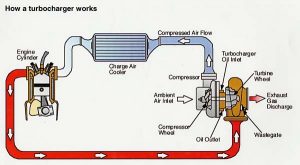
Cue the boost – and there goes the gas savings you thought you’d be getting.
I was pushing the gas pedal down a lot to keep the Equinox going up the mountain passes where I live and found that I was averaging around 22 MPG. That’s thirsty for a compact-sized crossover. Then I remembered how much it weighs – which is only about 300 pounds less than my 1976 Pontiac Trans-Am muscle car and it has a 7.5 liter V8 engine.
And my old Pontiac’s a lot quicker!
The restyled Equinox looks like it’s more SUV than crossover but it’s still all-crossover and that’s good if you prefer a vehicle that rides and handles like a sedan rather than a lifted 4×4. It’s powerful enough to not feel slow and once you’re up to speed, it is quiet – but the CVT in FWD models increases drivetrain noise while you’re getting up to speed. AWD models with the eight speed automatic are . . . quieter getting up to speed and feel (and sound) less tinny and small-engined overall, because the small engine isn’t revving as high or as long when the vehicle is accelerating.
Its small size makes it easy to park – and back out of – parking spots but there’s a blind spot on either side due to partial blocking of your view to the side that’s caused by a roughly four-inch wide and eight inch tall section of rear quarter panel that takes up a portion of each piece of what would otherwise be the rear side glass.
At 183.2 inches long, the Equinox is one of the larger compacts in its class. It is nearly three inches longer than a Toyota RAV4, for instance. So it’s surprising it has less room for cargo behind its second row (29.8 cubic feet) and with its second row folded down (63.5 cubic feet) than the smaller RAV4 has (37.6 cubic feet and 69.8 cubic feet respectively).
What the restyled Equinox does have is a bolder look than the RAV4 and others in this segment that have many functional virtues but look so much alike it’s hard to tell them apart.
Chevy worked hard to differentiate the Equinox from the crowd with this new, more squared-off shape and bigger/heavier-looking squat. Activ trims can be had with two-tone paint schemes and what look like a 4×4’s wagon wheels with tall (rather than short) sidewall tires, as if it were ready to do some rock-crawling. 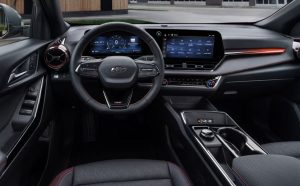
But don’t be fooled by the restyled Chevy’s hunkier new looks. This is not one meant for off-roading (or pulling). It’s as light-duty as the previous Equinox that looked a lot like the crossover it still is.
On the inside, there’s a Camaro-inspired dashboard with the dual LCD flatscreen displays canted toward the driver. There are also a pair of large, ball-type air vents on either end of the dash that allow for the airflow to be directed in every direction rather than just up-down and left-right.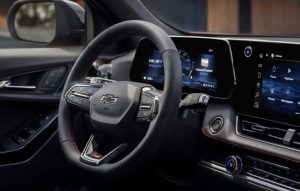
There isn’t a gear selector on the console, as has become usual. Instead there’s steering column-mounted stalk – just like there used to be in most automatic-equipped vehicles, before it became a thing to put a gear selector in the console to make things look sporty. Moving the gear selector to the steering column is ergonomically intelligent in that it’s easier to reach and it removes delicate electronics away from where you’re likely to spill coffee all over them.
There is also no key – at least, no key that must be put into an ignition switch and turned. Like almost every 2025 model year vehicle, the Equinox comes standard with an electronic transmitter fob and push-button ignition.
It’s interesting to note how quickly big LCD displays went from available only on the highest-end makes and models – such as the Mercedes S-Class and Audi A8 – to standard features in entry-level crossovers such as this one. It makes one wonder how the high-end makes and models continue to justify their high-end prices (especially given that many of them also have small, turbocharged engines now as well).
Also standard – like it or not – is a bevy of “driver assistance” electronic nannies that correct your driving, such as lane centering and traffic sign detection (the latter being a kind of preview of the speed limiting technology that’s almost certainly just around the corner).
All trims also come standard with a Wi-Fi hotspot and multiple new-style (oval) USB charge ports.
The Bottom Line
Chevy hasn’t fixed what’s not broken.
. . .
If you like what you’ve found here please consider supporting EPautos.
We depend on you to keep the wheels turning!
Our donate button is here.
If you prefer not to use PayPal, our mailing address is:
EPautos
721 Hummingbird Lane SE
Copper Hill, VA 24079
PS: Get an EPautos magnet or sticker or coaster in return for a $20 or more one-time donation or a $10 or more monthly recurring donation. (Please be sure to tell us you want a magnet or sticker or coaster – and also, provide an address, so we know where to mail the thing!)
If you like items like the Baaaaaa! baseball cap pictured below, you can find that and more at the EPautos store!






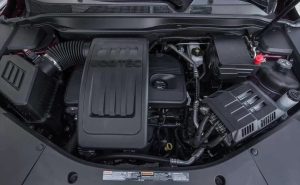

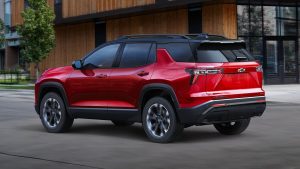
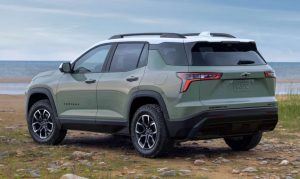
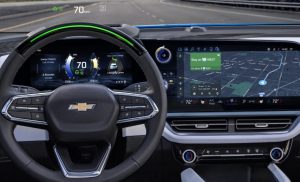






This thing was built by MBA/DEI/Union fucktards. Why would anyone buy these?
GM turbo four [or 3 with a belt in oil in their smaller CUVs] and GM derived CVT….plus GM electrics… what could possibly go wrong?
31 highway sucks, btw, for all that Rube Goldberg GM engineering used to achieve it.
Crash roll and burn GM.
I can replace my same size non aspirated 2005 GM that gets 23 city/32-35-37 highway, weighs 700 lbs less, has no nanny devices with a tall pig that uses more gas, has more complexity, more costly potential repairs, more federal monitoring, smaller and more stressed hyper active engine and a questionable potential for making it 20 years on the road for almost double what I paid for what I have right now.
No thanks. At only 86,000 miles, I have at least another 15 years of use out of what I have. And if I GAF…. a better choice for the environment.
With the 1.5L engine, GM will pay less in CAFE fines regardless of the MPG.
If the put a 5.3L V8 in this thing the gas mileage would improve. Especially with a CVT.
It seems like a good effort from GM but the reliability will suck and if you buy one you are providing material support to government gun-n-jail-backed UAW terrorists.
“The Equinox can get to 60 MPH in just over 8 seconds; an ’84 Chevette needed about twice as long to reach the same speed.”
I read that as “’84 Corvette” and I thought WTF!…LOL
Hi Anne,
Yup. I was there and I remember! “Muscle cars” of the early ’80s generally needed about 7-8 seconds to get to 60. About as quick as a new Honda RAV4 and not as quick as an older RAC4 with the V6…
Honda RAV4?…I thought WTF 🙂
I got an opportunity to drive the new Honda Civic hybrid. That thing moved!
Hi Anne,
My bad! Of course there is no such thing as a Honda RAV4! Honda makes the CR-V. But both it and the Toyota RAV4 are basically the same things.
Is the next trend going to be moving from 2L 4 cylinders to 1.5L?
Sorry, that’s just too small for the weight, I don’t care what you do to it.
Hi Dan,
Of course. But the point is to diminish engines until engines are gone.
“Except when it comes to saving you gas.”
Haha! So true. My old 5.3V8 Tahoe got quite a bit better mileage than the wonder-6 in the pickup.
Thanks for the review! I still enjoy reading about them despite all the government fuckery.
20 years of “progress:” 2005 Equinox 3.4 (no turbo) V6, 185 HP, 3,740 lbs, 0-60 in just over 7 seconds. Mileage 19/25.
Yep I just sold our 05 that we bought new. I “inherited” for my commuting to work vehicle when we got a new 17 for my wife. I think it had 180k on it and although a bit rusty it ran fine. That vehicle would move out. The 17 is a straight up slug compared to the 05.
Don’t think I would want to be the owner of one of these when it gets to ten years old.
Seems like a bad idea, too small engine, turbo and CVT. Three strikes your out Chevy…..
Eric, just a random thought that hit when I read about the LCD screen. My 2014 Mazda3 has one of the pop tart touch screen sticking out of the dash. A few months ago, I started it and the ‘infotainment’ system went berserk. Thing was randomly scrolling through menus and kept making phone calls all by itself! I shut it down and when I started it again, it was fine. I did my research and found that ‘ghost touching’ was a known problem with Mazda touchscreens and that there had been an advisory to replace them. Of course, my car was too old to get the screen replaced. After more research I found someone had created a little program that would disable the touchscreen so that it would just act as a display (have to use the knobs and buttons, which I already used anyway). Downloaded the program to a USB, plugged it in my car, and followed the directions to install it. Haven’t had any more ghost touching incidents since. Ain’t technology wonderful?
Least there is a fix. Most of the time there isn’t.
As vehicles get more expensive, maybe third party fixes and upgrades will become more common.
I’m just here for the T/A burnout video…
Hi Eric. We’ve had more than a few Equinox’s since they came out and we are considering getting this new gen maybe next year. I was cool with that until I realized the fwd comes with the CVT. No bueno for me on that as we buy our vehicles and keep them waaaayy after they’re paid off. Did you find the awd version much slower accelerating than the fwd? Did it have that heavy sluggish steering feel? That’s been my experience with awd cross overs I’ve driven.
Hi Rob,
There is almost no difference in terms of how quickly this thing gets to 60 with either tranny but there is a big difference in feel/sound (and probably also longevity). So I’d go with the AWD version to get the (geared) automatic over the CVT.
Thank you sir! Ok my feeling exactly if we were to get an Equinox anyways.
My brother & I were reminiscing about daddy’s 1973 Chevy K10. He paid $2700 for it which in today’s deflated FRNs is about $20,000. That’s $8,000 less than the base model of the Equinox.
The K10 had an inline six and three on the tree. It came with Chevy’s first post-EPA mandated bs and got terrible gas mileage due to some Rube Goldberg set of hoses returning vapors or fluids to the engine (I don’t know the detail). I do know daddy took his pocketknife & cut all those hoses & plugged ’em with bolts. He then got 22 mpg.
He’d always say the EPA thought getting 12 mpg was good but getting 22 mpg was bad. The point of this is that nothing has changed. As Eric stated, car that heavy should have a six cylinder but the EPA says that’s bad, and instead the consumer is left with a four banger with turbo. All of us in the EP community understand the ramifications on maintenance and long term ownership.
Oh, daddy dropped the air filter cover wingnut & it managed to make its way into the cylinder. He took the head off & pulled the mangled wingnut, reassembled & it ran fine. Plus he changed a fuel pump on the side of the road (remember when the pump wasn’t in the tank?).